

#TIE HEADSAIL CLEW TO ROLLER FURLING FREE#
Cheapest way would be to use your current genoa, buy an old sail of a similar size (sail shape doesn't matter too much), fit a wire luff rope and free fly it using the spinnaker halyard and tack to the bow roller.
#TIE HEADSAIL CLEW TO ROLLER FURLING PLUS#
For the sail to be strong enough for use reefed in heavy air, the sail will be constructed too heavy for lighter winds when you can handle a full-sized sail. We use twin matched headsails sewn together with one luff rope thus using one foil groove, one halyard plus two poles. Keep in mind that being reefable is a compromised that trades ease of reducing sail area for optimal performance. The sail is tacked down at the furling drum fed up into the groove in the extrusion, attached to the head swivel, and the jib halyard is attached to the top of the head swivel. Notice how the sail keeps a perfectly smooth, flat airfoil shape. Once the reef tack is set, the halyard is re-tensioned. Your crew reminds you to get the storm staysail handy. You tuck a second reef into your main to help balance the helm. As the halyard is eased, tack line pulls the reef tack to the tack fitting. Dropping the hanked-on staysail, you roughly flake the mass and tuck the hardware from the head, tack, and clew into the middle of the sailcloth so they don’t smack you as you carry it down below. The sail has a tack take-down line that goes from the reef tack, through the tack shackle and then back to a winch in the cockpit. The last sequence shows a sail with luff tape being reefed on a SwedeStar 37. Hanks are not a requirement for reefable jibs.

To shake the reef, lower the sail, unzip the rolled-up section, re-attach the jib’s tack, move the jib sheets and then re-set the sail. Finally, the sail is raised and the zipped-up section can be seen at the bottom of the sail. UK Sailmakers can build in a zipper system for sails that will stay reefed for long periods of time. The sail is dropped, the sheets are moved from the clew to the reef clew and then the foot is folded up and the reefed part of the sail is rolled and then zipped away. The catamaran sequence shows a reef being put jib on 24-foot Streaker cat PARADACTYL.

This boat mostly races doublehanded and benefits from the reef while sailing upwind once the wind goes over 12 knots. Shown here is the Express 37 LORA ANN with a slab reef in her 140% genoa. During slab reefing, whole sail is lowered a few feet and if the sail has horizontal leech flattening battens, they are not affected by the reefing process. On the other hand, with slab reefing you don’t lose the sail’s designed shape. The luff curve and most of the broad-seamed shape is in the front of the sail, which is removed during roller reefing. The distorted sail shapes created by roller furling are notoriously ugly – there are wrinkles, the draft moves aft and the leech hooks. Roller reefing is a compromise that reduces sail area at the expense of sail shape.


 0 kommentar(er)
0 kommentar(er)
